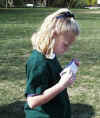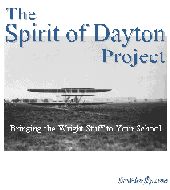 
Need to get your bearings?
Try our Museum Guide.
Want to ask a question? Tell us something?
Arrange a showing of one of our airplanes? Ping:
mailto:[email protected]
Meanwhile:
How about a
little music?
We have a selection of tunes that were
popular during the first days of aviation, performed by Sue Keller, courtesy the
Ragtime Press:
| |
THE SPIRIT OF DAYTON
1, our replica 1902
Wright Glider, is the centerpiece in a portable Wright Brothers museum,
designed to tour schools, museums, and other educational institutions.
Billed as "an encounter with the innovative minds of the Wright
Brothers," this museum also includes replicas of the 1878 Wright Bat,
the 1899 Wright Kite, and (in a few weeks) the 1901 Wright Wind Tunnel. Working with
educators, we are developing a project-oriented curriculum around these
artifacts that addresses state "proficiency outcomes" in
science, social studies, and language skills. This educational experience
also includes exercises in creative thinking to help the kids do a little
innovation of their own.

A typical school tour begins when we send the curriculum
to the teachers several weeks in advance of our visit. Using our
materials, the teachers familiarize the kids with the Wright brothers,
their friends and family, the times they lived in, the problem of
mechanical flight, and how the Wright brothers set out to solve it. This
will lay the groundwork so the young people can get the most out of our
one-day visit.
When we come, we will explain to the kids that we have
been conducting an archaeological expedition -- an exercise in "new
archaeology," like the Kon-Tiki adventure -- to help fill in the gaps
of the historical record. This helps us to recreate the lives of the
Wright brothers and how they worked through the scientific problems that
they faced. Then we will invite the kids to participate in this
expedition, letting them become part of the story.
First, we set the scene, describing the life in Dayton,
Ohio, where the Wright brothers lived at the end of the nineteenth
century. Using a special "airplane teeter-totter" , we
demonstrate what the Wrights hoped to contribute to the new science of
aviation -- control. As the
kids stand on the wings of this tipsy model airplane, they experience
firsthand how difficult it is to balance an aircraft in the air. A
quick round of a game we call "Air Traffic Control Requests"
drives home the principle of 3-axis control -- roll, pitch, and yaw.
Next, we explore the magic of lift.
The Wrights never expected to wrestle with this problem; they thought it
had been solved years ago. But it hadn't; the work that others did
before them was flawed. They had to start from scratch by making their own
wind tunnel. We ask the kids to conduct two gee-whiz experiments that
suggest a curved wing ought to produce more lift than a flat wing, then we
have them use the wind tunnel to prove it.
The last stop on this expedition is propulsion.
This yet another problem the Wrights never planned on solving, but thy
had to take it on. It wasn't that the work that had been done before was
wrong; it was that no one had ever done any work at all. Struggling with
the problem of trying to design an effective propeller, they suddenly have
a flash of insight. A propeller is a wing that spins in a circle! The kids
prove this to themselves by trying different propellers on a Wright
"Bat," a rubber band-powered helicopter Wilbur and Orville first
made when they were children. At the end of the day,
the kids will have met and mastered the same problems the Wrights faced,
and they will have gained an appreciation for how much work it takes to
make a dream a reality.

If you want to know more:
|
Click on a
photo to enlarge it.

Setting up the glider. We can conduct our
demonstrations out of doors if the weather is cooperative, or we can set
up in any 20-foot by 40-foot indoor space.

All set up. These are two of the Wright artifacts we
bring, the 1902 glider and the 1899 kite.

Wonderful day for a flight.

Where else can your students get this close to a
Wright airplane?

It amazes the kids to learn that in 1902 the
Wright glider was the largest and most
complex flying machine that anyone had ever successfully flown.
Playing "Air Traffic Control Requests," a
version of "Simon Says" that teaches kids the difference between
roll, pitch, and yaw.

Launching the Wright bat to test a propeller.

Making "inner tube boxes" to repeat the
experiment that led to the Wright's first important discovery.

A young mind encounters the innovative minds of the
Wright brothers.
|
| If you'd
like an attractive, illustrated booklet to take to a PTO or school
board meeting, right- click on the thumbnail to the right and choose
"Save Target As" (in Explorer) or "Save Link As" (in
Navigator) from the pop-up menu that appears. Save the ZIP file to a
folder on your hard drive. It's a big file -- 6 megs -- so it will take a
while to download. This unzips into a MicroSoft Word .doc file that
describes The Spirit of Dayton Project, the portable museum, and the
curriculum. It also includes commendations and comments. Please
print and distribute as many copies as you need.
If you'd like to arrange a visit to your
school or institution, you can ping us at:
mailto:[email protected]
Or you can contact us via snail-mail at:
Wright Brothers Aeroplane Company
P.O. Box 204
West Milton, OH 45383
|

Right-click on the image and download the zipped
file.
|

Back to the top |
